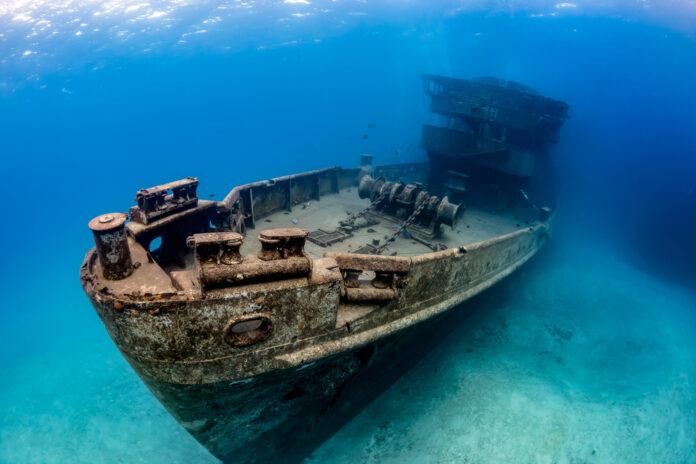The Titanic, discovered in 1985 deep beneath the ocean off of Newfoundland, is the most iconic shipwreck in the world. The massive luxury liner sank in 1912 after hitting an iceberg, but it was well preserved in its freezing resting place on the ocean floor.
In 2021, the Oceangate, a state-of-the-art submersible, made it possible to visit the site, but just two years later, everyone aboard the vessel was tragically killed when it imploded deep in the blue, and all the crew members were lost to the sea.
So, for obvious reasons, visiting the ship today is mostly off-limits. But luckily, if you’re a shipwreck enthusiast, there are plenty of other ships in the sea.
1. Grand Cayman
(Credit: Richard Whitcombe/Shutterstock)
The U.S. Navy launched the USS Kittiwake in 1945 and used it until 1994. In 2011, it was deliberately sunk off the coast of Grand Cayman to serve as an artificial reef.
Today, it’s one of the most famous and largest shipwrecks that’s regularly and easily visited. Located at Seven-Mile Beach in Grand Cayman, it’s a popular wreck to visit either as a snorkeler or a scuba diver. The 251-foot vessel boasts nearly 500 species of marine life, from garden eels to stingrays, sea turtles, and barracuda.
Additionally, according to Ashlea Flowers of the Cayman Islands Department of Tourism, the Cayman Islands are home to 240-plus accessible shipwrecks. “A few of the world-famous wrecks include the USS Kittiwake, Oro Verde, and Captain Keith Tibbetts,” Flowers says.
Read More: Shipwrecks Teem With Underwater Life, From Microbes To Sharks
2. Port of Veracruz, Mexico
Another hotspot for exploring sunken treasures is found off the coast of Mexico, says Alex Veka, founder of Vibe Adventures. Some wrecks include the C-50 Naufragio Vicente Palacio Riva Ship, which dates back to World War II and was sunk in the 2000s. It’s home to coral colonies a plenty with vibrant sea sponges and a host of other marine species.
Las Carcachas is another shipwreck site in the Port of Veracruz. The old cargo ship sank as a result of an accident nearly a century ago and divers can see the vehicles that it carried across the ocean as well as giant groupers, lobsters, lionfish and schools of amberjack, says Veka.
Read More: The $20 Billion Treasures of the San José Wreck Will Soon Be Saved
3. The Vasa, Sweden
(Credit: olgagorovenko/Shutterstock)
Travel writer Amber Haggerty shares a fascinating shipwreck that’s been excavated and is on exhibit at the Vasa Museum in Stockholm, Sweden. The Vasa sank on its maiden voyage in the Stockholm Harbor in 1628.
The Vasa was set to be the most powerful warship in the Baltic but in front of an audience and maybe even a host of musicians, the ship set sail and was immediately hit by a gust of wind that toppled it over and quickly engulfed it with water.
Chaos ensued as the captain tried unsuccessfully to save the ship. Many jumped from its decks and swam all the way back to shore. The problem with the ship, which was years in the making and delayed in its production, was faulty design. The sails and upper decks were too tall for the hull, which was top-heavy as a result.
Read More: No One Knows How Many Shipwrecks Exist, So How Do We Find Them?
4. The Lusitania – Ireland
(Credit: Everett Collection/Shutterstock)
Next to the Titanic, the Lusitania is one of the most famous shipwrecks in the world. And with good reason. Located just off the Old Head of Kinsale in Ireland at a water depth of 300 feet, the Lusitania was a British luxury ocean liner launched in 1906. At the time it was launched, the ship was the world’s largest passenger liner until it was sunk by a German U-boat in 1915.
Its sinking by the Germans contributed to the start of World War I. In all, 1198 people drowned with the ship, and 128 of them were Americans.
Today, experienced divers can visit the wreck, although it’s a difficult dive. The water can be turbulent and visibility poor. It also takes special training to visit such depths. Still, as one of the most important wrecks in the world, for some explorers, it’s worth the risk.
Read More: Historic Shipwrecks Preserved as Undersea Museums
Article Sources
Our writers at Discovermagazine.com use peer-reviewed studies and high-quality sources for our articles, and our editors review for scientific accuracy and editorial standards. Review the sources used below for this article:
Sara Novak is a science journalist based in South Carolina. In addition to writing for Discover, her work appears in Scientific American, Popular Science, New Scientist, Sierra Magazine, Astronomy Magazine, and many more. She graduated with a bachelor’s degree in Journalism from the Grady School of Journalism at the University of Georgia. She’s also a candidate for a master’s degree in science writing from Johns Hopkins University, (expected graduation 2023).
Source : Discovermagazine






